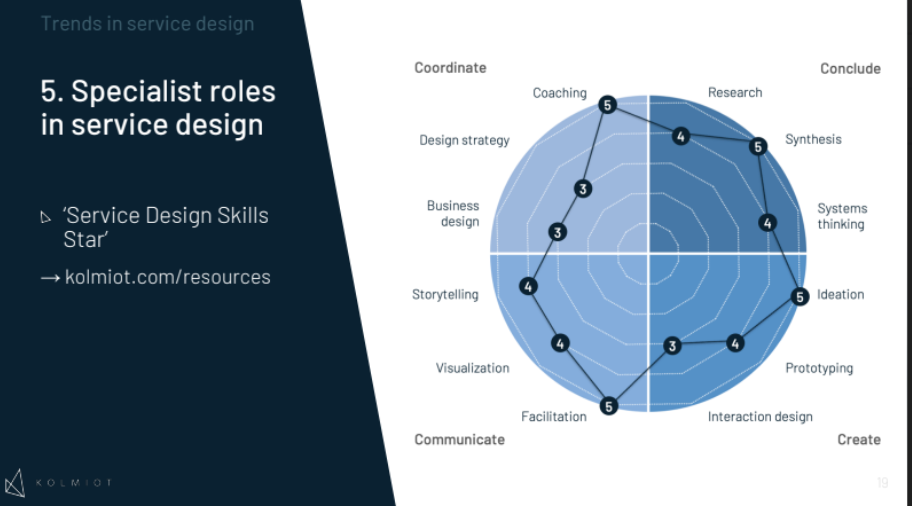Trends in the World of Service Design | Design Thinking Camp 2019
- Fabrica 360
- Sep 10, 2019
- 3 min read
Updated: Sep 17, 2020
Missed the Design Thinking Camp Sofia 2019? Here is a summary of Mr. Jesse Grime's talk.

Jesse is the founder of Kolmiot, an independent service design consultancy, Senior Vice President of the Service Design Network (SDN) and Editor-in-Chief of the service design journal ‘Touchpoint’. With eleven years’ experience as a service designer, and experience in London, Düsseldorf, Sydney and Amsterdam.
Among his clients are a wide range of international brands, including ING, ABN AMRO, Rabobank, Facebook, Optus, Vodafone, Orange and AkzoNobel, as well as the Dutch government. Jesse has specific expertise in service design for the financial sector, on innovation projects, as well as a coach, trainer and workshop facilitator. Jesse regularly organises and speaks at Dutch and international events for the service design community.

There are 5 trends in the service design world today:
1. Service design now has a greater mandate, its complexity is growing and there are large teams of service designers working together. Also, systems thinking is influencing the field.
The question is are we able to talk to our stakeholders in a way they can understand?
2. Designing for AI-delivered services
Our services are not just delivered by people, so the service provider’s role is changing. The interactions with Artificial intelligence are becoming intangible. At the same time there is a new breed of designers who will emerge and they will be linked to commercial design, classical design, computational design. Jesse raised a number of crucial questions:
"Whose role is it to design future service interactions? Do we have the skills and tools to design for chat-based interactions? How do current service designers become “computational designers”?
3. Service mindset vs. product mindset
Firms are focused on one thing and are missing the perspective – the holistic approach to creating products and services. The focus should be on:
Modern product management and service design
Silo effect
Service/experience economy
Semantics as a barrier
Service designers shouldn’t be in agile based product teams, but journey-based teams.
4. Data-informed service design is linked to:
More devices, more insights
Partnering data analyst and service designers
Journey analytics for observation, measurement and prediction
How do quality focused empathic service designed learn to harness the power of quantitative data?
5. Specialist roles in service design – there are different perceptions of what a designer is and does. Livework classified four specialist roles within the service design practice:

Relationship designer. Design relationships and personalities of services people interact with. Skills: playwright, psychology, machine empathy
Translator. Provides a bridge from data analytics and organisational needs to service design. Skills: organisational empathy, strategy, data literacy
Behavioural designer. Designs experiences that guide human behaviour. Skills: cognitive & behavioural science, design ethics
Visualizer. Simplifies and visualizes ideas, concepts, experiences and processes to enable different stakeholders to grasp complex subjects. Skills: illustration, synthesis, simplification
Jesse came up with 12 skills which service designers typically possess, to some extent or other: “Research”, “Synthesis”, “Systems thinking”, “Ideation”, “Prototyping”, “Interaction design”, “Facilitation”, “Visualization”, “Storytelling”, “Business design”, “Design strategy” and “Coaching”. A little more analysis, and I he able to cluster them into four overarching groupings: “Conclude”, “Create”, “Communicate” and “Coordinate”.

This “skill star” can deliver two main benefits. Service designers can apply it to themselves, and present the result when they’re seeking work, to better communicate their capabilities. And forward-thinking (and service design-mature!) employers could even plot the desired skills configuration for a job opening they have, to assist job-seekers in qualifying themselves.
----
Drop us a line at hey@fabrica360.eu if you are looking for a partner to help you with breaking down the silos in your organisation and empowering employees to contribute to innovation.
---
Ask a quote for our Service Design Masterclass. Now fully adapted and offered online.
---



Comments